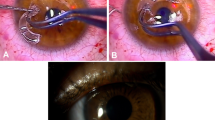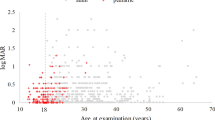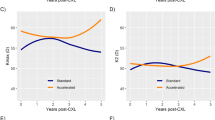Abstract
Purpose
To evaluate the safety and efficacy of implanted Kerarings in patients with mild, moderate, and severe keratoconus.
Patients and methods
A 12-month retrospective case series of 70 eyes of 70 patients who underwent Keraring implantation with the Zeiss Visumax femtosecond laser. Patients were stratified into three groups according to their topography as mild (mean K <48 D) moderate (48–55 D) or severe (>55 D). Main outcome measures were visual acuity, manifest refraction, and corneal topography. Complications were recorded.
Results
A total of 66 patients completed the 12-month follow-up. In all, 4 rings were explanted, 3 due to no improvement in visual function and 1 due to corneal neovascularization. Also, 4 rings were repositioned. In mild disease (n=28), BCVA increased to 0.10 logMAR, sphere decreased to −1.54 D, cylinder decreased to 2.54 D, Kmax decreased to 46.25 D, and keratometric astigmatism to 3.88 D (P<0.01 for each compared with preoperative values). No patients lost vision. In moderate disease (n=27), sphere decreased to −4.06 D, cylinder decreased to 3.47 D, Kmax decreased to 51.69 D, and keratometric astigmatism to 4.56 D (P<0.05 for each compared with preoperative values). In severe disease (n=11), BCVA increased to 0.34 logMAR, Kmax decreased to 57.65 D, and keratometric astigmatism to 5.07 D (P<0.05 for each compared with preoperative values).
Conclusion
Femtosecond laser-assisted Keraring implantation is a safe and minimally invasive treatment option to improve the refraction and visual function in patients with keratoconus. Patients with mild keratoconus are more likely to have a favourable outcome following Keraring implantation.
Similar content being viewed by others
Log in or create a free account to read this content
Gain free access to this article, as well as selected content from this journal and more on nature.com
or
References
Garcia-Lledo M, Feinbaum C, Alio JL . Contact lens fitting in keratoconus. Compr Ophthalmol Update 2006; 7 (2): 47–52.
Doyle SJ, Hynes E, Naroo S, Shah S . PRK in patients with keratoconic topography picture: the concept of a physiological ‘displaced apex syndrome’. Br J Ophthalmol 1996; 80: 25–28.
Wittig-Silva C, Chan E, Islam FM, Wu T, Whiting M, Snibson GR . A randomized, controlled trial of corneal collagen cross-linking in progressive keratoconus. Ophthalmology 2014; 121: 812–821.
Fleming JF, Reynolds AE, Kilmer L, Burris TE, Abbott RL, Schanzlin DJ . The intra-stromal corneal ring: two cases in rabbits. J Refract Surg 1987; 3: 227–232.
Colin J, Cochener B, Savary G, Malet F . Correcting keratoconus with intracorneal rings. J Cataract Refract Surg 2000; 26: 1117–1122.
Pinero DP, Alio JL . Intracorneal ring segments in ectatic corneal disease- a review. Clin Exp Ophthalmol 2010; 38: 154–167.
Carrasquillo KG, Rand J, Talamo JH . Intacs for keratoconus and post LASIK ectasia: mechanical versus femtosecond laser assisted channel creation. Cornea 2007; 26: 956–962.
Gore DM, Shortt AJ, Allan BD . New clinical pathways for keratoconus. Eye 2013; 27: 329–339.
Watson MP, Anand S, Bhogal M, Gore D, Moriyama A, Pullum K et al. Cataract surgery outcomes in eyes with keratoconus. Br J Ophthalmol 2014; 98: 361–364.
Shabayek MH, Alio JL . Intrastromal corneal ring segment implantation by femtosecond laser for keratoconus correction. Ophthalmology 2007; 114: 1643–1652.
Coskunseven E, Kymionis GD, Tsiklis NS, Atun S, Aslan E, Jankov MR et al. One year results of intrastromal corneal ring segment implantation (KeraRing) using femtosecond laser in patients with keratoconus. Am J Ophthalmol 2008; 145: 775–779.
Alio JL, Shabayek MH, Belda JI, Correas P, Diez Feijoo E . Analysis of results related to good and bad outcomes of Intacs implantation for keratoconus correction. J Cataract Refract Surg 2006; 32: 756–761.
Ertan A, Kamburoglu G . Intacs implantation using femtosecond laser for management of keratoconus: comparison of 306 cases in different stages. J Cataract Refract Surg 2008; 34 (9): 1521–1526.
Boxer Wachler BS, Christie JP, Chandra NS, Chou B, Korn T, Nepomuceno R . Intacs for keratoconus. Ophthalmology 2003; 110: 1031–1041.
Vega-Estrada A, Alio JL, Brenner LF, Javaloy J, Plaza Puche AB, Barraquer RI et al. Outcome analysis of intracorneal ring segments for the treatment of keratoconus based on visual, refractive and aberrometric impairment. Am J Ophthalmol 2013; 155: 575–584.
Kling S, Marcos S . Finite-element modeling of intrastromal ring segment implantation into a hyperelastic cornea. Invest Ophthalmol Vis Sci 2013; 54 (1): 881–889.
Coskunseven E, Kymionia GD, Tsiklis NS, Atun S, Arslan E, Signs CS et al. Complications of intrastromal corneal ring segment implantation using a femtosecond laser for channel creation: a survey of 850 eyes with keratoconus. Acta Ophthalmol 2011; 8954–8957.
Kwitko S, Severo NS . Ferrara intracorneal ring segments for keratoconus. J Cataract Refract Surg 2004; 30: 812–820.
Chan CC, Sharma FM, Wachler BS . Effect of inferior-segment Intacs with and without C3-R on keratoconus. J Cataract Refract Surg 2007; 33: 75–80.
Ertan A, Karacal H, Kamburoglu G . Refractive and topographic results of transepithelial cross-linking treatment in eyes with intacs. Cornea 2009; 28: 719–723.
Henrique MA, Izquierdo L, Bernilla C, McCarthy M . Corneal collagen cross-linking before Ferrara intrastromal corneal ring implantation for the treatment of progressive keratoconus. Cornea 2012; 31: 740–745.
El-Raggal TM . Sequential versus concurrent Kerarings insertion and corneal collagen cross-linking for keratoconus. Br J Ophthalmol 2011; 95: 37–41.
Kymionis GD, Siganos CS, Tsiklis NS, Anastasakis A, Yoo SH, Pallikaris AI et al. Long term follow up of Intacs in Keratoconus. Am J Ophthalmol 2007; 143: 236–244.
Alio JL, Shabayek MH, Artola A . Intracorneal ring segments for keratoconus correction: long term follow up. J Cataract Refract Surg 2006; 32: 978–985.
Colin J . European clinical evaluation: use of Intacs for the treatment of keratoconus. J Cataract Refract Surg 2006; 32: 747–755.
Author information
Authors and Affiliations
Corresponding author
Ethics declarations
Competing interests
The authors declare no conflict of interest.
Additional information
disclaimer
This is original research which has not previously been submitted for publication.
Rights and permissions
About this article
Cite this article
Wilde, C., Naylor, S., Varga, Z. et al. Keraring implantation using the Zeiss Visumax femtosecond laser in the management of patients with keratoconus. Eye 31, 916–923 (2017). https://doi.org/10.1038/eye.2017.13
Received:
Accepted:
Published:
Issue date:
DOI: https://doi.org/10.1038/eye.2017.13
This article is cited by
-
Outcomes of a Single-Segment Intrastromal Corneal Ring in Early Keratoconus and Early Pellucid Marginal Degeneration
International Ophthalmology (2022)



